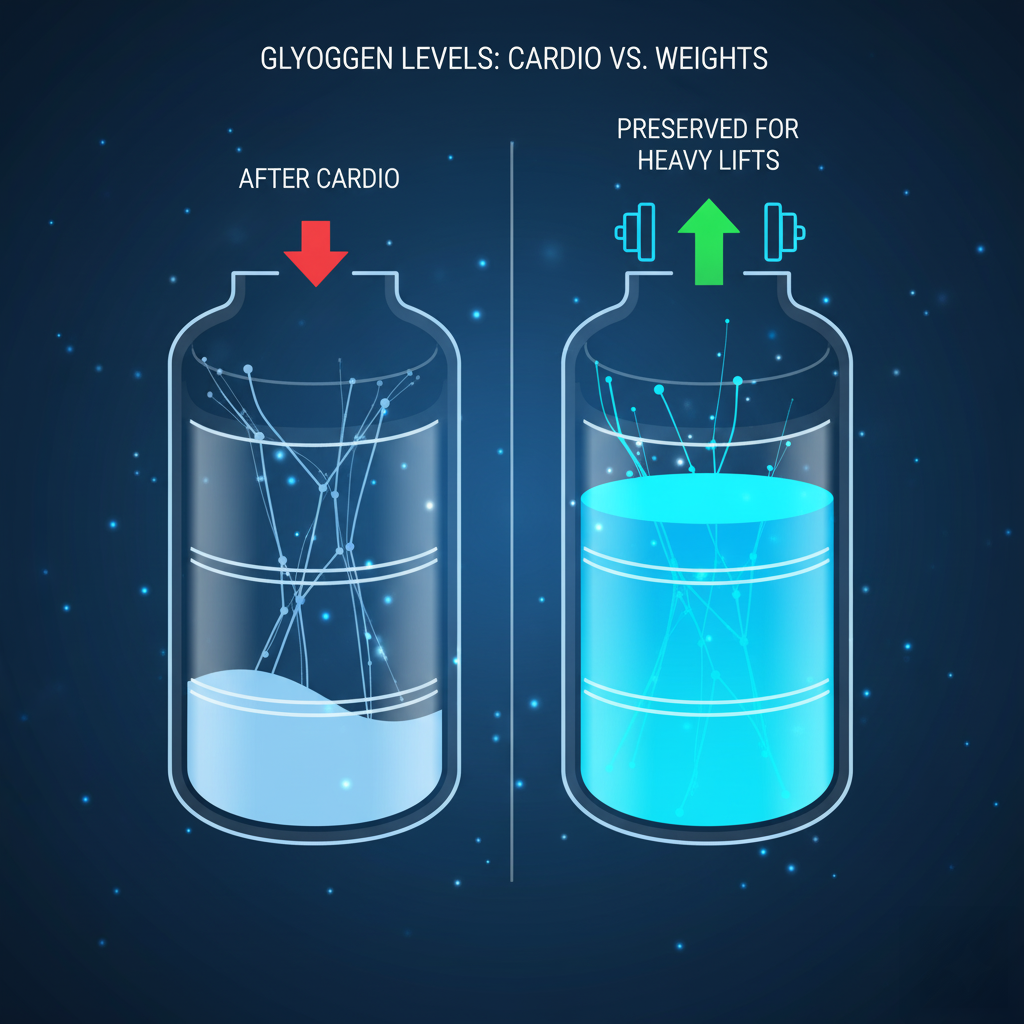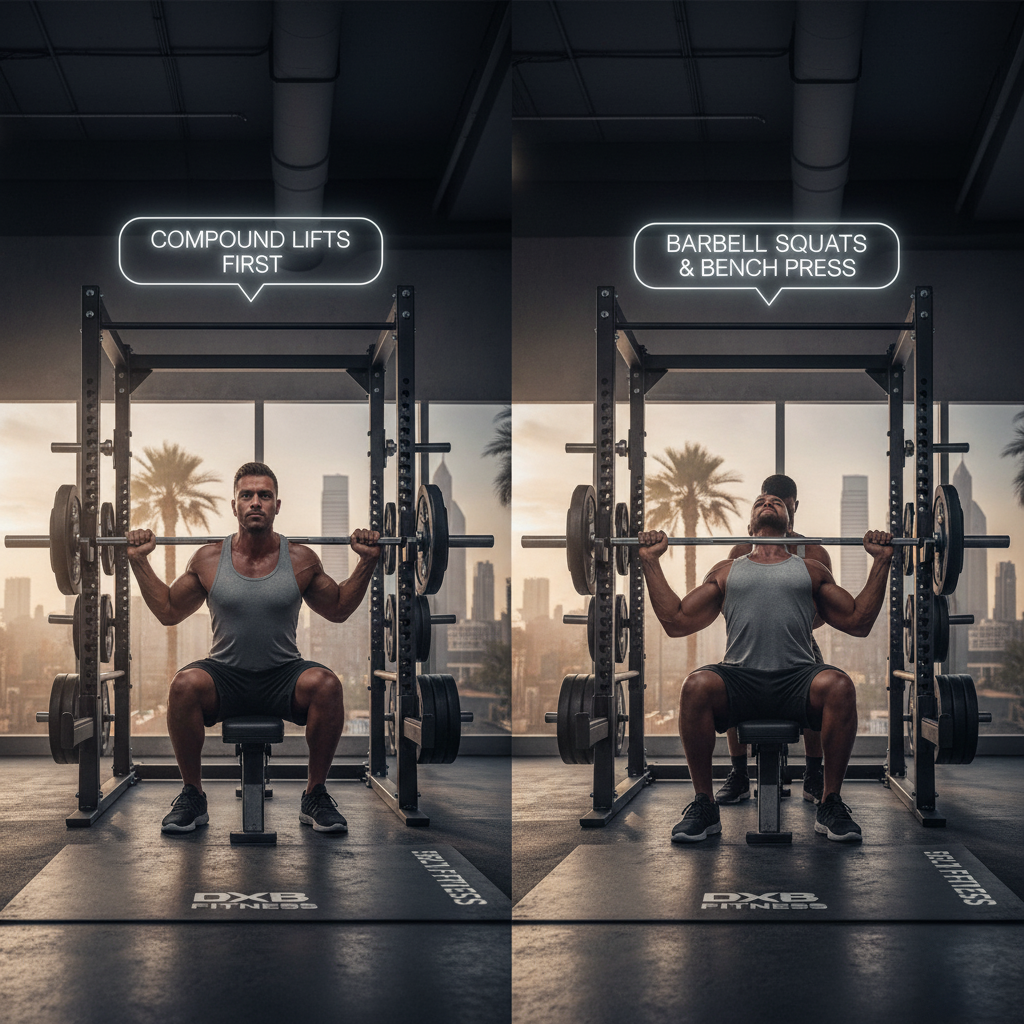Stepping into a gleaming gym in Dubai or Abu Dhabi, you’re armed with ambition and a solid workout plan. But then the age-old question hits you: treadmill or squat rack first? One fitness influencer swears that cardio first torches fat, while a bodybuilding forum insists it’s the fastest way to kill your gains. This workout order confusion is more than just a minor headache; it’s a source of frustration that can lead to wasted effort and stalled progress, leaving you wondering if you’re accidentally ruining your own results by not structuring your workout.
Forget the conflicting advice and generic answers. This is not another article rehashing the same debate. This is your definitive, goal-driven framework for structuring your gym workout routine in the UAE. We’ll move beyond the simple “before or after” question to give you a science-backed system for sequencing your training based on your specific goal—whether that’s maximum muscle gain, accelerated fat loss, or peak endurance.
We will dive into the science of workout order, provide a clear, goal-oriented guide to making the right choice for you, and even give you actionable weekly plans you can start using today. It’s time to train smarter, not just harder.
The Great Debate: Understanding the Science Behind Workout Order
To solve the puzzle of workout order, we first need to understand what’s happening inside our bodies. When you combine cardio and strength training in the same session—a practice known as concurrent training—your body has to make choices about how it allocates resources. The primary resource in question? Energy.
Your muscles store a ready-to-use fuel called glycogen. Heavy, explosive movements like squats and bench presses rely heavily on this glycogen to generate power. Intense cardiovascular exercise also taps into these same glycogen stores. When you perform a long or intense cardio session before lifting, you essentially drain the fuel tank, leaving less energy available for your strength workout. This can lead to reduced strength, fewer reps, and ultimately, a less effective muscle-building stimulus.
This phenomenon is often called the “interference effect.” A landmark meta-analysis of 21 different studies published in the Journal of Strength and Conditioning Research confirmed that while combining cardio and lifting doesn’t harm strength development, it can significantly interfere with muscle growth (hypertrophy) and power development when compared to lifting weights alone.[1]
However, this doesn’t mean cardio is the enemy of muscle. The interference effect is nuanced. The key takeaway is that the order in which you perform your exercises directly impacts which goal you are prioritizing. By understanding this, you can strategically structure your workout to maximize your results. For those interested in a deeper scientific dive, the NSCA Concurrent Training Guidelines provide excellent information.

Your Goal is Your Guide: The Right Answer for YOU
There is no single “best” answer to the cardio vs. weights question—only the best answer for your specific goal. Your primary objective is the ultimate compass for structuring your workout. Let’s break down the optimal sequence for the most common fitness goals. To simplify your decision, use this quick guide:
- Your Goal is Maximum Muscle Gain? Lift Weights First.
- Your Goal is Accelerated Fat Loss? Lift Weights First.
- Your Goal is Peak Endurance? Do Cardio First.
- Your Goal is General Health & Fitness? You have flexibility, but consistency is king.
For a more detailed look at why this order matters, the ACE Fitness Guide to Workout Sequencing offers a great goal-based perspective.
For Maximum Muscle Gain: Prioritize Lifting
If your main goal is to build muscle size (hypertrophy), the science is clear: lift weights before you do cardio. This is a non-negotiable rule for maximizing your gains. By hitting the weights first, you attack your strength training with full glycogen stores and a fresh central nervous system. This allows you to lift heavier, complete more reps, and create the maximal mechanical tension and metabolic stress needed to trigger muscle growth.
The fear of “ruining gains with cardio” is valid if the order and type of cardio are incorrect. A powerful study from the Journal of Sports Science and Medicine provides stark evidence. Researchers found that a group performing resistance training and cardio on separate days saw a 12.1% increase in muscle size, while the group that did cardio immediately after lifting saw only a 5.0% increase.[2] That’s less than half the growth, simply due to timing.
To avoid this, perform your weightlifting session first. Afterward, if you include cardio, opt for low-impact, low-intensity steady-state (LISS) cardio, such as 20-30 minutes of walking on an incline or a light session on the elliptical. This will still provide cardiovascular benefits without significantly hampering your recovery and muscle-building processes. As certified strength and conditioning specialists often advise, you should always perform the most neurologically demanding exercises—heavy compound lifts—when you are at your freshest.

For Accelerated Fat Loss: Lift First, Then Burn
For those whose primary goal is fat loss, the optimal workout structure is also to lift weights first, then do cardio. This sequence creates a powerful metabolic advantage. Your weightlifting session will primarily use up your stored muscle glycogen. By the time you hop on the treadmill or cross-trainer, your body’s preferred, easy-access fuel source is depleted, encouraging it to tap into its secondary source: stored body fat.
Research has supported this approach, showing that participants who lifted weights first experienced significantly greater reductions in overall body fat compared to those who did cardio first. To amplify this effect, consider finishing your workout with a session of High-Intensity Interval Training (HIIT). A 15-20 minute HIIT session post-lifting can dramatically increase your metabolic rate for hours after you leave the gym, a phenomenon known as Excess Post-exercise Oxygen Consumption (EPOC), leading to greater overall calorie burn.
While some debate the “best time to do cardio for fat loss,” a 2023 study in the journal Obesity found an association between morning exercise (7 a.m. to 9 a.m.) and lower body mass index.[3] However, experts agree that consistency is far more important than timing. The best routine is the one you can stick to, and the lift-then-burn method is a scientifically sound strategy for maximizing fat loss regardless of the time of day.
For Peak Endurance: Lead with Cardio
Here is the major exception to the rule. If your primary goal is to become a better runner, cyclist, or swimmer, you should do cardio first. When endurance is the top priority, you need to perform that activity when your body is fresh and your energy levels are at their peak. This allows you to push your performance, hit your target pace or distance, and stimulate the specific adaptations your body needs to improve its cardiovascular efficiency.
As exercise physiologist Katie Lawton, MEd, has noted, endurance-focused individuals should prioritize their main sport. Following your primary cardio session with a targeted strength training workout can then complement your endurance goals. This strength work should focus on building resilience in supporting muscles and correcting imbalances, rather than chasing maximum muscle size, which helps prevent injury and improve overall performance.
For General Health & Fitness: You Have Flexibility
If you’re training for overall well-being, longevity, and general fitness without a specific competitive goal, the order is much less critical. The most important factor for you is consistency. The “best” workout is the one you enjoy and will show up for regularly.
Authoritative bodies like the Mayo Clinic recommend a balanced routine that includes at least 150 minutes of moderate-intensity cardio and two full-body strength training sessions per week.[4] You can achieve this by splitting cardio and weights into different days, doing a short cardio warm-up before lifting, or simply doing whichever activity you dislike first to get it out of the way. For this goal, adherence trumps perfect sequencing. For more foundational advice on building a sustainable routine, explore these Mayo Clinic’s Fitness Program Tips.

How to Structure Your Workout Week in the UAE: Sample Plans
Knowing the principles is one thing; putting them into practice is another. Here are some sample plans you can implement at popular UAE gyms like Fitness First to create an optimal workout structure. These templates provide a clear path to combining cardio and lifting effectively. For more ideas on how to blend these two modalities, this guide on Combining Cardio and Strength Training is a valuable resource.
The 4-Day Upper/Lower Split for Muscle Gain & Fat Loss
This is a highly effective and popular split that allows you to train muscle groups with enough intensity and frequency for growth while providing ample recovery time. It systematically allows for 48 hours of rest for each muscle group before it’s trained again.
- Monday: Upper Body Strength + LISS Cardio
- Strength: Focus on compound exercises like Bench Press, Barbell Rows, Overhead Press, and Pull-ups.
- Cardio: 20-30 minutes of incline walking or light cycling post-workout.
- Tuesday: Lower Body Strength
- Strength: Focus on compound exercises like Squats, Deadlifts, Leg Press, and Lunges.
- Cardio: None (focus on recovery).
- Wednesday: Active Recovery or Rest
- Light activity like walking, stretching, or yoga.
- Thursday: Upper Body Strength + HIIT
- Strength: Focus on different rep ranges or accessory movements like Dumbbell Incline Press, Seated Cable Rows, and Lateral Raises.
- Cardio: 15-minute HIIT session on the assault bike or rower post-workout.
- Friday: Lower Body Strength
- Strength: Focus on accessory movements like Romanian Deadlifts, Leg Curls, and Calf Raises.
- Cardio: None.
- Saturday & Sunday: Rest
Fueling for Performance: How to Avoid the Post-Cardio Energy Crash
One of the biggest complaints from people who do cardio first is having “no energy for weights after cardio.” This fatigue is often a direct result of improper fueling and hydration. To maximize gym results, your nutrition strategy is just as important as your training plan.
According to experts from medical institutions like UCLA Health, what you eat before and after your workout is critical.[5] To avoid an energy crash, focus on consuming easily digestible carbohydrates 60-90 minutes before your workout. A banana, a small bowl of oatmeal, or a piece of toast can top off your glycogen stores and provide the sustained energy needed for a tough session.
Post-workout nutrition is all about recovery and repair. The Mayo Clinic Health System advises that consuming 15-30 grams of protein after a workout can help maximize muscle protein synthesis, the process by which your body builds new muscle.[6] Combine this protein with carbohydrates to replenish the glycogen you just burned. Simple, effective options include:
- A protein shake with a banana
- Greek yogurt with berries
- Chocolate milk
- Chicken breast with a small sweet potato
Properly fueling your body before and after training is the key to ensuring you have the energy to perform at your best and the nutrients to recover effectively.
Frequently Asked Questions (FAQ)
Can a short cardio warm-up before lifting help build muscle?
Absolutely. A light 5-10 minute warm-up on a treadmill or bike is highly beneficial. Its purpose is to increase your core body temperature, improve blood flow to the muscles, and prime your nervous system for the heavy lifting to come. This is very different from a full, glycogen-depleting cardio session. Some research has even suggested a longer, 20-minute warm-up may help build muscle, but for most people, 5-10 minutes of dynamic movement is the perfect preparation.
How much cardio is too much when trying to build muscle?
There’s no single magic number, as “too much” depends on your personal recovery capacity, nutrition, and sleep. However, a good rule of thumb to avoid “ruining gains” is to limit high-intensity cardio (HIIT) to 1-2 sessions per week. For moderate, steady-state cardio, 2-3 sessions of 20-45 minutes each is a safe and effective range for most people whose primary goal is muscle gain. Listen to your body; if your lifting performance is consistently suffering, you may need to scale back your cardio volume or intensity.
Should I do cardio and weights on different days?
If your schedule allows, separating your cardio and weightlifting sessions onto different days is an excellent strategy, particularly for maximizing muscle growth. This approach allows you to dedicate 100% of your energy and focus to each session without any interference effect. As seen in research, separating the two modalities can optimize hypertrophy.[2] The main downside is that it requires more visits to the gym per week, which may not be practical for everyone.

Conclusion: Your Goal, Your Workout Order
The debate over cardio before or after weights is finally settled: the right answer is entirely dependent on your primary goal. You are now empowered with a clear, science-backed framework to stop guessing and start structuring your workouts with purpose.
- For muscle gain and fat loss, make weightlifting your priority. Hit the weights first to maximize strength and deplete glycogen, then follow up with smart, goal-appropriate cardio.
- For peak endurance, lead with cardio to perform at your best when you are freshest.
- For general health, focus on consistency and do what feels best to keep you showing up.
Choose the sample workout plan that best fits your ambitions, commit to it for the next 4-6 weeks, and fuel your body for success. You have the knowledge to build the perfect gym workout routine. Now go get the results you deserve.
Share your progress or ask any questions in the comments below!
Disclaimer: This article provides general fitness advice. Consult with a healthcare professional or certified personal trainer before beginning any new exercise program, especially if you have pre-existing health conditions.
References
- Wilson, J. M., Marin, P. J., Rhea, M. R., Wilson, S. M., Loenneke, J. P., & Anderson, J. C. (2012). Concurrent training: a meta-analysis examining interference of aerobic and resistance exercises. Journal of Strength and Conditioning Research, 26(8), 2293-2307. Retrieved from https://journals.lww.com/nsca-jscr/abstract/2012/08000/concurrent_training__a_meta_analysis_examining.35.aspx
- Tomiya, S., Kikuchi, N., & Nakazato, K. (2017). Moderate Intensity Cycling Exercise after Upper Extremity Resistance Training Interferes Response to Muscle Hypertrophy but Not Strength Gains. Journal of Sports Science & Medicine, 16(3), 309–315. Retrieved from https://www.ncbi.nlm.nih.gov/pmc/articles/PMC5592291/
- Ma, T., et al. (2023). The role of timing of day and sequencing of objectively measured physical activity in the associations with obesity. Obesity.
- Mayo Clinic Health System. (N.D.). 5 tips for a well-rounded fitness program. Retrieved from https://www.mayoclinichealthsystem.org/hometown-health/speaking-of-health/5-tips-for-a-well-rounded-fitness-program
- UCLA Health. (N.D.). What to eat before and after a workout, based on your workout type. Retrieved from https://www.uclahealth.org/news/article/what-eat-before-and-after-workout-based-your-workout-type
- Mayo Clinic Health System. (N.D.). 5 nutrition tips to maximize your workouts. Retrieved from https://www.mayoclinichealthsystem.org/hometown-health/speaking-of-health/5-nutrition-tips-to-maximize-your-workouts



